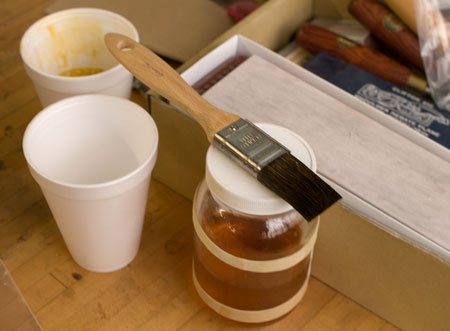|
|
12/15/2009 |
 This blog entry has some hopefully interesting information on early finishes but after that an apology for some shellac issues we have been having. This blog entry has some hopefully interesting information on early finishes but after that an apology for some shellac issues we have been having.
First the interesting stuff:
The first mention of shellac as a finish in English is from 1805 (it was used earlier but just not written about in English). Shellac is mostly a late 18th and later finish. Before that furniture was finished with either an oil finish, colored paint, Beeswax and turpentine, or a resin based spirit (alcohol) finish. When shellac was introduced it replaced the resin based finishes quickly and they fade from usage.
What this practically means is that if you are making 18th century furniture reproductions a shellac based or French polish isn't necessarily historically accurate. I'm not an expert in finishes so my dates might be a little suspect but I'm in the ballpark.
Anyway, the retailer in me thought about introducing a line of pre-shellac resin based finishes. Some of the early finishes are a mix of resins, some have oil in them. there are lots of formula. But I figured that a resin based finish you could mix yourself would be of real interest to anyone doing period furniture.
In the book: "The First American Furniture Finisher's Manual - a Reprint of "The Cabinet-Maker's Guide" of 1827 (based on an earlier edition of 1809) a whole bunch of these pre-shellac finishes (along with some shellac finishes) are mentioned along with the idea of using a fine pumice block for rubbing wood smoother. So I got myself a fine pumice block (not the coarse kind used for cleaning) and tried it out. Worked great. Then I went to Kremer Pigments and got the ingredients for some resin based spirit finishes. I just copied a formula from the book and did a spreadsheet of conversions. The original formula is for a couple of gallons of varnish but I reduced the quantities to something manageable for a test. So there is the formula for making "the best hard white varnish":| Alcohol | 0.2 qt. | | Gum Sandrach | 2.5 oz. | | Gum Mastic | 0.5 oz. | | Gum Anime | 0.1 oz. |
The finish dissolved nicely, we put in on, rubbed it out, let it dry, added a few more coats, rubbed some more and got a really nice finish.
EXCEPT it sucked big time compared to shellac!!! If you try this you will instantly see why the resin finishes became obsolete. The resin never gets really hard. The finish looks great but can easily take a fingernail mark of worse. Unlike shellac which give a great hard coat, resin is just too darn fragile and even if it is historically accurate, it's just not a great finish. It's like a soft plastic film. Also the ingredients - even wholesale are expensive and I just didn't see a product in it.
Now the same book that this finish is listed in also has a few dozen other finishes with various other ingredients. The book is late enough so that some formula use shellac, but a common addition is oil. Oil was also a common finish and in many respects it's a better finish than resin but it takes ages to harden. And the formula are balances between shine, ease of application, durability, dry time, etc. In the Joiner and Cabinet Maker the finish used on the dresser was a transitional finish which included shellac and turpentine. Stephen Shepherd is starting to post a lot of entries in his blog on finishes as he researches his next book.
The finish project was a flop but the additional research we did at the time gave us both the gramercy brushes that are so popular and our German Tiger Flake Shellac.
Unfortunately we have been having a real problem with the German Shellac which is why only the Garnet (and maybe Amber if we get a chance to pack it this week) is shown in stock. More on that in a couple of days in part 2.
|
Join the conversation |
|
 Joel's Blog
Joel's Blog Built-It Blog
Built-It Blog Video Roundup
Video Roundup Classes & Events
Classes & Events Work Magazine
Work Magazine


 This blog entry has some hopefully interesting information on early finishes but after that an apology for some shellac issues we have been having.
This blog entry has some hopefully interesting information on early finishes but after that an apology for some shellac issues we have been having.
Any idea when you will have your stock in?
The carcase saws and kits are all in.
Sash saws are a little behind my guess with Holiday vacations we won't see them until next year. We still need the backs to come in an then there's sharpening and assembly etc.